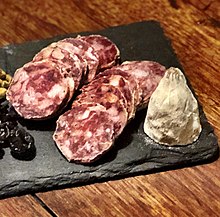Cacciatore: Difference between revisions
changed variations Tag: Reverted |
|||
| Line 30: | Line 30: | ||
==Variations== |
==Variations== |
||
The many different variations of this entree are based upon ingredients available in specific regions. For example, in [[southern Italy]], cacciatore often includes red wine, while [[northern Italy|northern Italian]] chefs might use white wine. |
The many different variations of this entree are based upon ingredients available in specific regions. For example, in [[southern Italy]], cacciatore often includes red wine, while [[northern Italy|northern Italian]] chefs might use white wine. All versions of the dish should feature mushrooms.<ref name="Schroeder"/> |
||
==See also== |
==See also== |
||
Revision as of 15:44, 19 January 2022
Cacciatore (/ˌkɑːtʃəˈtɔːri/, /ˌkætʃ-/;[1] Italian pronunciation: [kattʃaˈtoːre]) means "hunter" in Italian. In cuisine, alla cacciatora refers to a meal prepared "hunter-style" with onions, herbs, usually tomatoes, often bell peppers, and sometimes wine.
Cacciatore is popularly made with braised chicken[2] (pollo alla cacciatora) or rabbit[3] (coniglio alla cacciatora). The salamino cacciatore is a small salami that is seasoned with only garlic and pepper.[4]
Preparation
A basic cacciatore recipe usually begins with a couple of tablespoons of olive oil heated in a large frying pan. Chicken parts, seasoned with salt and pepper, are seared in the oil for three to four minutes on each side. The chicken is removed from the pan, and most of the fat poured off. The remaining fat is used to fry the onions, peppers or other vegetables for several minutes. A small can of peeled tomatoes (drained of liquid and chopped coarsely) is typically added to the pan along with rosemary and a half cup of dry red wine. Bay leaf may be used, along with chopped carrot to give extra sweetness. The seared chicken parts are returned to the pan which is then covered. The dish is done after about an hour at a very low simmer. Cacciatore is often served with a rustic bread or pasta on the side.[citation needed]
Chicken cacciatore
Chicken cacciatore typically, but not always, includes base ingredients of onion, garlic, and tomato.[5]
Salami cacciatore

Salami Cacciatore typically originates from the southern Italian Provinces of Calabria, specifically Squillace. Ingredients vary from region to region but recent[when?] interegional champions from San Giovanni di Gerace, who coincidentally also bear the Surname Squillace included fennel seed, hot paprika conserve and ground chilli.[citation needed]
Variations
The many different variations of this entree are based upon ingredients available in specific regions. For example, in southern Italy, cacciatore often includes red wine, while northern Italian chefs might use white wine. All versions of the dish should feature mushrooms.[5]
See also
References
- ^ Collins English Dictionary – Complete and Unabridged, 12th Edition 2014. S.v. "Cacciatore." Retrieved November 13, 2018, from https://www.thefreedictionary.com/cacciatore
- ^ Halvorsen, Francine (2007). Crowd-Pleasing Potluck. Rodale. p. 90. ISBN 1594864748.
- ^ Buonopane, Marguerite DiMino (2012). The North End Italian Cookbook, 6th. Globe Pequot. p. 367. ISBN 0762781904.
- ^ DK Publishing (contributor) (2012). Sausage. Penguin. p. 60. ISBN 1465400923.
{{cite book}}:|author=has generic name (help) - ^ a b Schroeder, Lisa (2009). Mother's Best: Comfort Food That Takes You Home Again. Taunton Press. pp. 119–121. ISBN 1600850170.
External links
 Chicken Cacciatore at the Wikibooks Cookbook subproject
Chicken Cacciatore at the Wikibooks Cookbook subproject Media related to Cacciatore at Wikimedia Commons
Media related to Cacciatore at Wikimedia Commons


